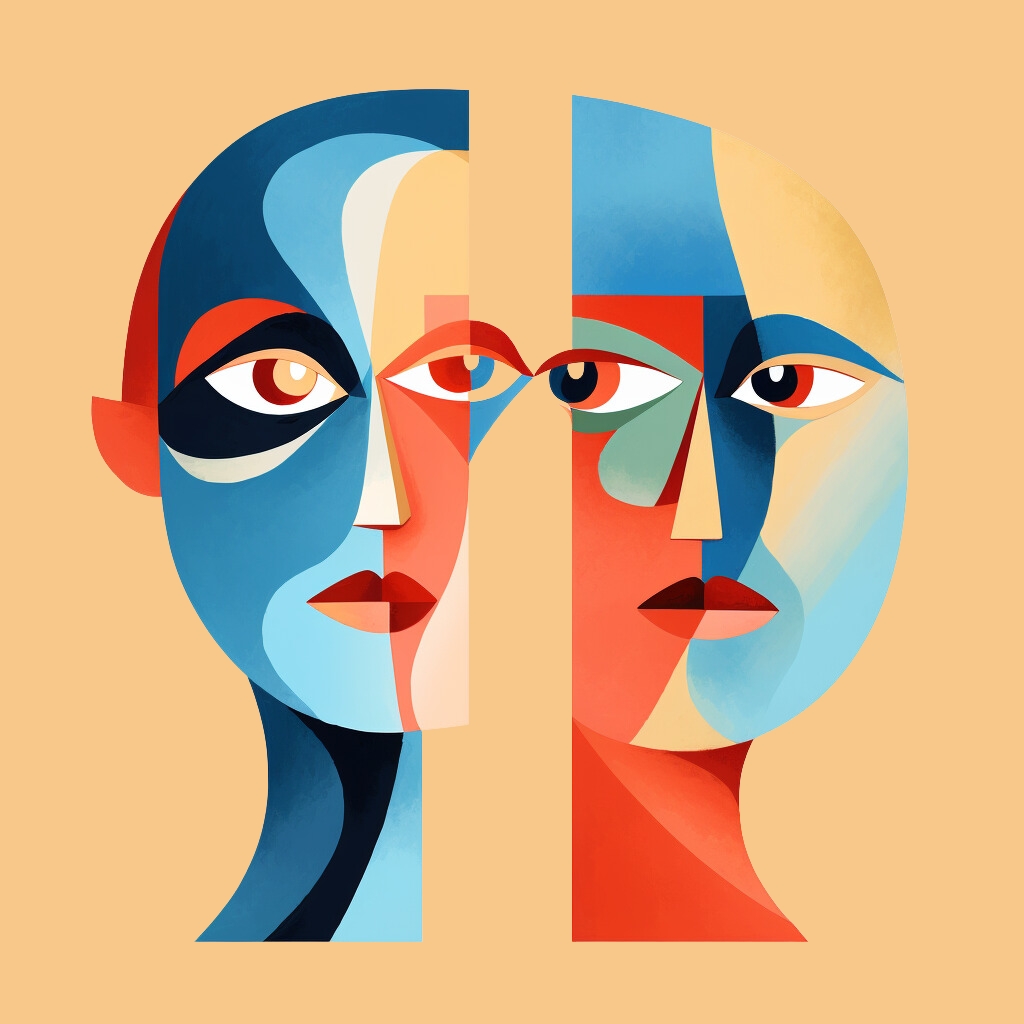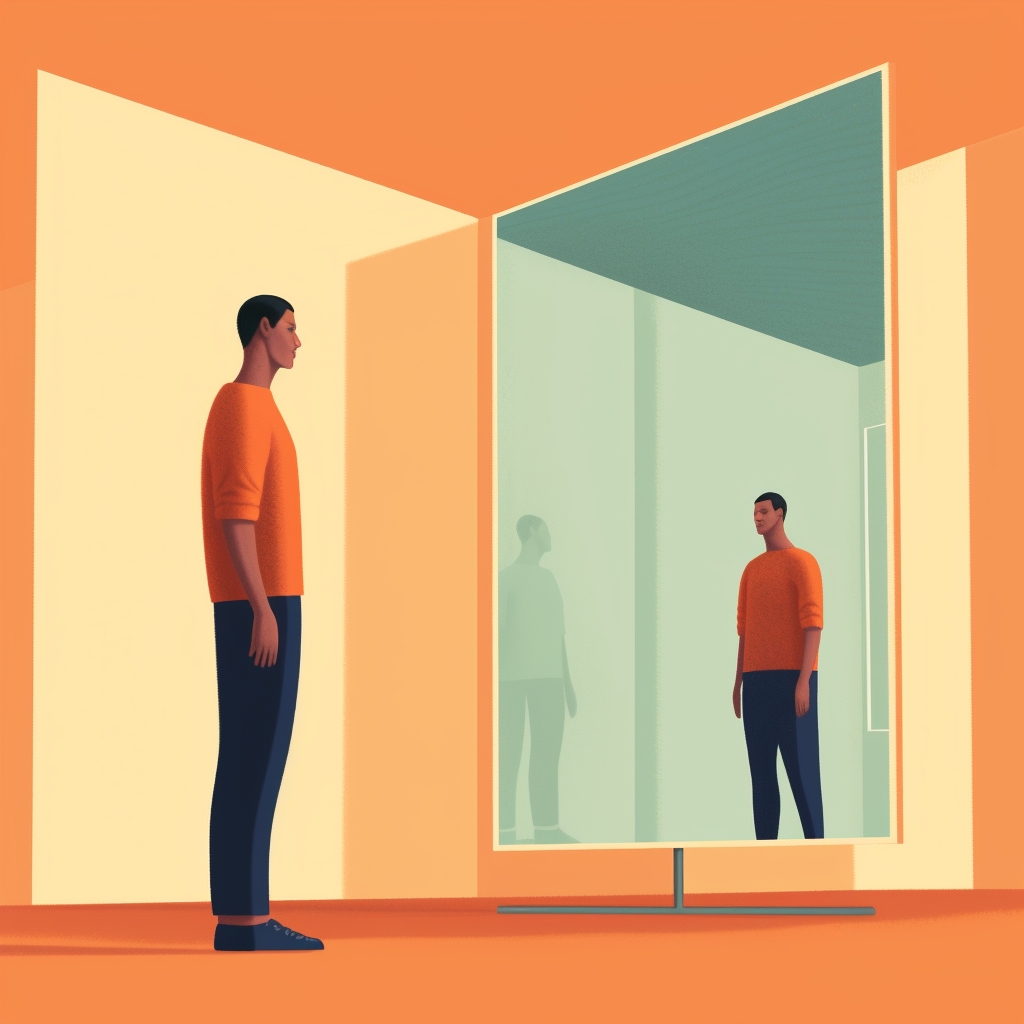Bipolar Disorder: Types, Symptoms, and Diagnosis

Bipolar disorder affects a significant portion of the global population, with prevalence rates varying across different studies. According to the World Health Organization (WHO), bipolar disorder affects approximately 1% of the global population (WHO, 2021). It can occur in people of all ages, genders, and cultural backgrounds.
Studies have shown that bipolar disorder is associated with a higher risk of suicide. According to the American Psychiatric Association (APA), individuals with bipolar disorder are at a 15-fold increased risk of suicide compared to the general population (APA, 2020). The severe mood swings and emotional turmoil experienced during depressive episodes contribute to this elevated risk.
This article will discuss bipolar disorder’s definition, its types, causes, symptoms, and treatments.

What Is Bipolar Disorder?
Bipolar disorder meaning, also known as manic-depressive illness, is a chronic mental health condition characterized by extreme mood swings. Individuals with bipolar disorder experience intense shifts in mood, energy levels, and activity levels, which can significantly impact their daily lives. These mood swings alternate between episodes of mania and depression, hence the term “bipolar.” The manic episodes involve heightened energy, euphoria, and impulsive behavior, while the depressive episodes are marked by profound sadness, hopelessness, and loss of interest.
The impact of bipolar disorder extends beyond the individual diagnosed with the condition. It affects their relationships, work productivity, and overall quality of life. The episodes of mania and depression can disrupt daily functioning, leading to difficulties in maintaining stable employment, managing relationships, and achieving personal goals.
Bipolar Disorder Types
There are different types of bipolar disorder as below:

Bipolar I Disorder
Bipolar I disorder is a subtype of bipolar disorder characterized by the presence of manic episodes. These episodes are the defining feature of this particular type. To meet the diagnostic criteria for bipolar I disorder, an individual must have experienced at least one manic episode.
Characteristics and Diagnostic Criteria
Manic episodes in bipolar I disorder are characterized by an elevated, expansive, or irritable mood lasting for at least one week (APA, 2013). During this period, individuals may exhibit an inflated sense of self-esteem, decreased need for sleep, increased talkativeness, racing thoughts, and high levels of energy. They may also engage in impulsive behaviors such as excessive spending or risky sexual encounters.
Manic Episodes
Manic episodes are marked by significant impairment in functioning and can lead to serious consequences if left untreated. The intensity and duration of manic episodes vary among individuals. Some may experience a single manic episode, while others may have recurrent episodes interspersed with periods of normal mood or depression.
Depressive Episodes
In addition to manic episodes, individuals with bipolar I disorder may also experience depressive episodes. These episodes are characterized by persistent sadness, hopelessness, and a loss of interest or pleasure in previously enjoyed activities. Symptoms may include changes in appetite, sleep disturbances, fatigue, and difficulty concentrating.
Psychotic Features
In some cases, bipolar I disorder may also involve psychotic features during manic or depressive episodes. Psychotic symptoms can include hallucinations (perceiving things that are not real) or delusions (holding false beliefs). These features can further complicate the clinical presentation and treatment approach for individuals with bipolar I disorder.
Bipolar II Disorder
Bipolar II disorder is another subtype of bipolar disorder that is characterized by the presence of both hypomanic and major depressive episodes. Unlike bipolar I disorder, individuals with bipolar II disorder do not experience full-blown manic episodes.

Characteristics and Diagnostic Criteria
To meet the diagnostic criteria for bipolar II disorder, individuals must have experienced at least one hypomanic episode and one major depressive episode (APA, 2013). Hypomanic episodes are similar to manic episodes but are less severe and do not cause significant impairment in functioning. Major depressive episodes in bipolar II disorder are similar to those in bipolar I disorder and involve profound sadness, loss of interest, and other depressive symptoms.
Hypomanic Episodes
Hypomanic episodes in bipolar II disorder are characterized by an elevated or expansive mood lasting for at least four consecutive days (APA, 2013). During these episodes, individuals may experience increased energy, heightened self-esteem, racing thoughts, and increased involvement in goal-directed activities. Although individuals with hypomania may feel more productive or energetic, they often maintain a higher level of functionality compared to those with manic episodes.
Major Depressive Episodes
Similar to bipolar I disorder, individuals with bipolar II disorder also experience major depressive episodes. These episodes are characterized by a persistent depressed mood, loss of interest or pleasure, changes in appetite or weight, sleep disturbances, and feelings of worthlessness or excessive guilt (APA, 2013). Major depressive episodes can significantly impact daily functioning and quality of life.

Cyclothymic Disorder
Cyclothymic disorder is a milder form of bipolar disorder characterized by chronic mood instability. Individuals with the cyclothymic disorder experience numerous periods of hypomanic symptoms and depressive symptoms that do not meet the criteria for a full manic or major depressive episode.
Characteristics and Diagnostic Criteria
To be diagnosed with the cyclothymic disorder, the symptoms must persist for at least two years (one year in children and adolescents) and not be absent for more than two months at a time (APA, 2013). The mood swings in cyclothymic disorder are less severe compared to bipolar I or II disorders, but they can still significantly impact daily functioning.
Mild Mood Swings
Individuals with cyclothymic disorder experience mild and frequent mood swings, cycling between periods of hypomanic-like symptoms and depressive symptoms. These mood swings can be unpredictable and may cause difficulty maintaining stable relationships, employment, and overall well-being.
Bipolar Disorder Causes and Risk Factors
You might ask what causes bipolar disorder; different factors can cause bipolar disorder; some of them are as below:
Genetic Factors
Genetic factors play a significant role in the development of bipolar disorder. Research suggests that there is a strong hereditary component to the disorder, with a higher prevalence among individuals who have a family history of the condition. Twin and family studies have shown a higher concordance rate for bipolar disorder among identical twins compared to fraternal twins, indicating a genetic influence (Craddock & Sklar, 2013). Specific genes and variations in gene expression related to neurotransmitter systems, such as dopamine and serotonin, have been implicated in bipolar disorder (Forstner et al., 2017). However, it is important to note that genetic factors alone do not determine the development of the disorder, and additional environmental factors also play a role.
Neurochemical Imbalances
Neurochemical imbalances in the brain, particularly involving neurotransmitters, have been implicated in bipolar disorder. Dysregulation of neurotransmitter systems, such as dopamine, serotonin, and norepinephrine, may contribute to mood instability and alternating episodes of mania and depression (Goodwin & Jamison, 2007). Abnormalities in the functioning of these neurotransmitters can disrupt the normal regulation of mood, emotions, and behavior, leading to the characteristic symptoms of bipolar disorder.
Environmental Triggers
Environmental factors can interact with genetic and neurochemical factors to influence the onset and course of bipolar disorder. Stressful life events, such as trauma, loss, or significant life changes, can act as triggers for mood episodes in susceptible individuals. These events can disrupt the delicate balance of neurotransmitters and activate underlying genetic vulnerabilities (Post et al., 2018). Additionally, disruptions in sleep patterns, social rhythms, and circadian rhythms have been associated with an increased risk of mood episodes in bipolar disorder (Jones et al., 2019).

Co-occurring Disorders
Bipolar disorder often co-occurs with other mental health conditions. Common comorbidities include anxiety disorders, substance use disorders, attention-deficit/hyperactivity disorder (ADHD), and eating disorders (Merikangas et al., 2011). The presence of these co-occurring disorders can complicate diagnosis and treatment and may require an integrated approach to address the multiple symptoms and challenges experienced by individuals with bipolar disorder.
Substance Abuse
Substance abuse, particularly alcohol and illicit drug use, is a significant risk factor for the development and worsening of bipolar disorder. Substance abuse can trigger mood episodes, interfere with the effectiveness of medications, and contribute to poorer treatment outcomes (Goldberg et al., 2001). Additionally, substance abuse can exacerbate the neurochemical imbalances associated with bipolar disorder, leading to more frequent and severe mood swings.

bipolar disorder symptoms and Warning Signs
Here are some of the common symptoms and signs of bipolar disorder:
Manic Episode Symptoms
- Euphoria and Grandiosity: During a manic episode, individuals with bipolar disorder may experience intense feelings of euphoria, extreme happiness, or an exaggerated sense of well-being. They may have inflated self-esteem and an exaggerated belief in their abilities and achievements (APA, 2013). These feelings of grandiosity can lead to unrealistic expectations and an overestimation of one’s capabilities.
- Increased Energy and Activity Levels: Manic episodes are characterized by a significant increase in energy levels and a heightened state of arousal. Individuals may feel restless, and agitated, and have a decreased need for sleep without experiencing fatigue (APA, 2013). They may engage in multiple activities simultaneously, taking on numerous projects or tasks without completing them.
- Impulsivity and Risky Behavior: Impulsivity is a common feature of manic episodes. Individuals may engage in impulsive and reckless behaviors without considering the potential consequences. This can include excessive spending, risky sexual behavior, substance abuse, or making impulsive decisions that have far-reaching implications (APA, 2013). Impaired judgment and a decreased ability to evaluate the potential risks are hallmark symptoms of a manic episode.
Depressive Episode Symptoms
- Persistent Sadness and Hopelessness: Depressive episodes in bipolar disorder are characterized by a persistent and pervasive feeling of sadness, emptiness, or hopelessness. Individuals may experience an overwhelming sense of despair that can interfere with their daily functioning and overall quality of life (APA, 2013). These feelings often persist for an extended period, typically lasting at least two weeks.
- Loss of Interest and Pleasure: A hallmark symptom of depressive episodes is a significant loss of interest or pleasure in previously enjoyed activities. Individuals may experience a diminished ability to experience joy, reduced motivation, and a lack of enthusiasm for activities that used to be pleasurable (APA, 2013). This loss of interest can extend to social interactions, hobbies, and even basic self-care routines.
- Fatigue and Sleep Disturbances: Depressive episodes in bipolar disorder are often accompanied by feelings of fatigue, lack of energy, and a general sense of exhaustion. Individuals may experience difficulty in initiating or maintaining sleep, leading to sleep disturbances such as insomnia or hypersomnia (APA, 2013). Changes in sleep patterns can further exacerbate depressive symptoms and contribute to a cycle of fatigue and emotional distress.

Bipolar Disorder Diagnosis And Assessment
The diagnosis of bipolar disorder is made based on specific criteria outlined in the Diagnostic and Statistical Manual of Mental Disorders (DSM-5) published by the American Psychiatric Association (APA, 2013). To receive a diagnosis of bipolar disorder, an individual must meet the following criteria:
- Presence of at least one manic episode, which may be preceded or followed by hypomanic or major depressive episodes in bipolar I disorder.
- Presence of at least one hypomanic episode and one major depressive episode in bipolar II disorder.
- Symptoms causing significant distress or impairment in social, occupational, or other important areas of functioning.
- Symptoms not better accounted for by another medical condition or substance abuse.
Medical and Psychiatric Evaluation
To accurately diagnose bipolar disorder, a comprehensive medical and psychiatric evaluation is essential. This evaluation involves gathering information about the individual’s medical history, family history, and a thorough assessment of their current symptoms. The healthcare provider will review the person’s physical health, medications, and potential substance use. Additionally, they will inquire about the presence of any co-occurring psychiatric disorders and assess for any possible medical conditions that could mimic bipolar symptoms (APA, 2013).
bipolar disorder test, Screening Tools, and Assessments
Several screening tools and assessments are available to aid in the diagnosis and assessment of bipolar disorder. These tools can help gather information about symptoms, severity, and functioning. Some commonly used assessments include:
- Mood Disorder Questionnaire (MDQ): The MDQ is a self-report questionnaire that screens for symptoms associated with bipolar disorder and helps identify individuals who may require further evaluation (Hirschfeld et al., 2000).
- Bipolar Spectrum Diagnostic Scale (BSDS): The BSDS is a self-report scale that assesses the presence and severity of bipolar spectrum symptoms, aiding in the identification of potential bipolar disorder cases (Ghaemi et al., 2005).
- Young Mania Rating Scale (YMRS) and Hamilton Depression Rating Scale (HDRS): These clinician-administered scales are used to assess the severity of manic and depressive symptoms, respectively, and monitor treatment response over time (Young et al., 1978; Hamilton, 1960).
These screening tools and assessments, along with a comprehensive clinical evaluation, can assist healthcare professionals in making an accurate diagnosis of bipolar disorder.

Bipolar Disorder Treatments
There are different ways of treatment for bipolar disorder; some of them are as below:
Medication for Bipolar Disorder
- Mood Stabilizers: Mood stabilizers are a common class of medications used to manage bipolar disorder. They help stabilize mood swings, prevent or reduce the intensity of manic and depressive episodes, and maintain a more balanced emotional state. Lithium is one of the most commonly prescribed mood stabilizers and has demonstrated efficacy in reducing manic and depressive symptoms (Goodwin et al., 2016). Other mood stabilizers, such as valproate and lamotrigine, may also be prescribed based on individual needs and preferences.
- Antidepressants: Antidepressant medications may be prescribed in combination with mood stabilizers to manage depressive symptoms in bipolar disorder. However, their use requires careful consideration due to the potential risk of inducing manic or hypomanic episodes (Pacchiarotti et al., 2017). Antidepressants are typically prescribed in conjunction with a mood stabilizer and under close monitoring to minimize the risk of mood destabilization.
Psychotherapy
- Cognitive-Behavioral Therapy (CBT): Cognitive-Behavioral Therapy is a type of psychotherapy that focuses on identifying and modifying negative thought patterns and behaviors. It can be beneficial in managing bipolar disorder by helping individuals recognize and challenge distorted thinking, develop coping strategies, and improve problem-solving skills (Scott et al., 2006). CBT can be effective in reducing the frequency and severity of mood episodes and improving overall functioning.
- Interpersonal and Social Rhythm Therapy (IPSRT): Interpersonal and Social Rhythm Therapy is a psychotherapeutic approach specifically developed for bipolar disorder. It emphasizes the importance of maintaining regular daily routines, managing life stressors, and improving interpersonal relationships. IPSRT aims to stabilize social rhythms and sleep-wake cycles, which are often disrupted in bipolar disorder (Frank et al., 2005). By establishing stability and structure, IPSRT can help prevent mood episodes and enhance overall stability.
- Family-Focused Therapy (FFT): Family-Focused Therapy involves the participation of family members in the treatment process. It aims to enhance communication, problem-solving, and support within the family unit. FFT provides education about bipolar disorder, helps family members understand the illness, and teaches them how to provide a supportive and stable environment (Miklowitz et al., 2003). By involving the family, this therapy approach can improve treatment adherence and reduce relapse rates.
Lifestyle Changes and Self-Care
- Sleep Regulation: Regulating sleep patterns is crucial for managing bipolar disorder. Maintaining a consistent sleep schedule, practicing good sleep hygiene, and avoiding sleep deprivation can help stabilize mood and prevent mood episodes (Bauer et al., 2017). Creating a relaxing bedtime routine, avoiding stimulants close to bedtime, and ensuring a comfortable sleep environment are important aspects of sleep regulation.
- Stress Management: Stress can trigger or exacerbate episodes of bipolar disorder. Learning stress management techniques, such as relaxation exercises, mindfulness meditation, and engaging in enjoyable activities, can help individuals better cope with stressors and reduce the risk of mood destabilization (Michalak et al., 2011). Seeking social support, setting realistic goals, and maintaining a healthy work-life balance are also essential for managing stress.
- Healthy Diet and Exercise: Adopting a healthy lifestyle is beneficial for individuals with bipolar disorder. Eating a balanced diet that includes nutrient-rich foods, such as fruits, vegetables, whole grains, and lean proteins, can support overall well-being (Sarris et al., 2015). Regular exercise, such as aerobic activities or yoga, has been shown to improve mood, reduce stress, and enhance overall mental health (Cooney et al., 2013).
Managing Bipolar Disorder in Everyday Life
Here are some other ways to manage bipolar disorder:
- Establishing Routine and Stability: Maintaining a structured daily routine can be highly beneficial for individuals with bipolar disorder. Establishing regular sleep patterns, eating meals at consistent times, and engaging in daily activities can help stabilize mood and reduce the risk of mood episodes (Colom et al., 2014). By setting a predictable schedule, individuals can enhance their overall sense of stability and well-being.
- Managing Triggers and Stressors: Identifying and managing triggers and stressors is essential for managing bipolar disorder. Triggers can vary from individual to individual but may include certain life events, relationship difficulties, or specific environmental factors (Bauer et al., 2018). It is important to develop coping strategies to effectively deal with these triggers. This may involve practicing relaxation techniques, engaging in stress-reducing activities, or seeking support from loved ones or mental health professionals.
- Recognizing Early Warning Signs: Being able to recognize early warning signs of mood shifts or impending episodes can empower individuals to take proactive measures to manage their condition. These signs may include changes in sleep patterns, increased irritability, changes in energy levels, or alterations in thinking patterns (Berk et al., 2017). Keeping a mood journal or using mood-tracking apps can help individuals monitor and identify these early warning signs, allowing for timely interventions.
- Communicating with Healthcare Providers: Maintaining open and honest communication with healthcare providers is crucial for effectively managing bipolar disorder. Regular appointments with psychiatrists or therapists can provide opportunities to discuss treatment progress, address concerns, and make any necessary adjustments to the treatment plan (National Institute for Health and Care Excellence, 2014). It is important to report any changes in symptoms or side effects of medications to ensure appropriate management of the condition.
HealWiser’s Last Piece of Advice
Managing bipolar disorder in everyday life involves establishing routine and stability, managing triggers and stressors, recognizing early warning signs, and maintaining open communication with healthcare providers. These strategies empower individuals to take an active role in their well-being and enhance their quality of life.
If you or someone you know is experiencing symptoms of bipolar disorder, it is important to seek help and treatment. Bipolar disorder is a complex condition, but with appropriate interventions, individuals can lead meaningful and fulfilling lives. Remember that professional support, including mental health professionals, support groups, and loved ones, can provide valuable assistance and understanding throughout the journey of managing bipolar disorder.
You are not alone, and there is hope for a brighter future with proper support and treatment.
Share your experience with HealWiser and others in the comments section below this post.





